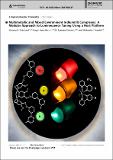Files in this item
Multimetallic and mixed environment iridium(III) complexes : a modular approach to luminescence tuning using a host platform
Item metadata
| dc.contributor.author | Pritchard, Victoria E. | |
| dc.contributor.author | Rota Martir, Diego | |
| dc.contributor.author | Zysman-Colman, Eli | |
| dc.contributor.author | Hardie, Michaele J. | |
| dc.date.accessioned | 2017-05-05T08:30:12Z | |
| dc.date.available | 2017-05-05T08:30:12Z | |
| dc.date.issued | 2017-07-03 | |
| dc.identifier | 249440086 | |
| dc.identifier | ec8f7dd8-8c29-4399-97e1-7e40f8c8d694 | |
| dc.identifier | 85018975822 | |
| dc.identifier | 000404550000011 | |
| dc.identifier.citation | Pritchard , V E , Rota Martir , D , Zysman-Colman , E & Hardie , M J 2017 , ' Multimetallic and mixed environment iridium(III) complexes : a modular approach to luminescence tuning using a host platform ' , Chemistry - A European Journal , vol. 23 , no. 37 , pp. 8839-8849 . https://doi.org/10.1002/chem.201700237 | en |
| dc.identifier.issn | 0947-6539 | |
| dc.identifier.other | ORCID: /0000-0001-7183-6022/work/56639104 | |
| dc.identifier.uri | https://hdl.handle.net/10023/10709 | |
| dc.description | We thank the EPSRC for support (EP/M02105X/1) and for studentship (VEP, DTG award 1238852) and University of St Andrews for studentship (DRM). | en |
| dc.description.abstract | Mononuclear and trinuclear bis-cyclometalled Ir(III)complexes of the host ligands tris(4-[4’-methyl-2,2’-bipyridyl]methyl)cyclotriguaiacylene (L1) and tris(4-(4’-methyl-2,2’-bipyridyl)carboxy)cyclotriguaiacylene (L2) have been prepared. Complexes [{Ir(ppy)2}3(L1)](PF6)3 1.1, [{Ir(ppy)2}(L1)](PF6)31.2,[{Ir(ppy)2}3(L2)](PF6)3 2.1 and [{Ir(ppy)2}(L2)](PF6)3 2.2 (where ppy =phenylpyridinato) showed distinct photophysical properties according to L-ligand with L1 complexes comparatively blue-shifted in solution, with longer lifetimes and higher quantum yields. The mixed bis-cyclometallated Ir(III) complexes [{Ir(ppy)2}{Ir(dFppy)2}2(L1)](PF6)3 1.3,, [{Ir(ppy)2}{Ir(dFppy)2}2(L2)](PF6)3 2.3,[{Ir(ppy)2}2{Ir(dFppy)2}(L1)](PF6)3 1.4 and[{Ir(ppy)2}2{Ir(dFppy)2}(L2)](PF6)3 2.4 (where dFppy = 2,4-difluorophenylpyrinato) were also synthesised. Steady-state and time-resolved spectroscopy along with electrochemical investigation show that Ir(C^N)2 chromophores within these mixed Ir-environment species behave as isolated centres with no energy transfer or electronic communication between them. | |
| dc.format.extent | 11 | |
| dc.format.extent | 1714118 | |
| dc.language.iso | eng | |
| dc.relation.ispartof | Chemistry - A European Journal | en |
| dc.subject | Cyclometallated | en |
| dc.subject | Cyclotriveratrylene | en |
| dc.subject | Iridium | en |
| dc.subject | Luminescence | en |
| dc.subject | Trinuclear complexes | en |
| dc.subject | QD Chemistry | en |
| dc.subject | DAS | en |
| dc.subject.lcc | QD | en |
| dc.title | Multimetallic and mixed environment iridium(III) complexes : a modular approach to luminescence tuning using a host platform | en |
| dc.type | Journal article | en |
| dc.contributor.sponsor | EPSRC | en |
| dc.contributor.institution | University of St Andrews. School of Chemistry | en |
| dc.contributor.institution | University of St Andrews. EaSTCHEM | en |
| dc.contributor.institution | University of St Andrews. Organic Semiconductor Centre | en |
| dc.identifier.doi | 10.1002/chem.201700237 | |
| dc.description.status | Peer reviewed | en |
| dc.date.embargoedUntil | 2017-05-03 | |
| dc.identifier.url | http://onlinelibrary.wiley.com/doi/10.1002/chem.201700237/full#footer-support-info | en |
| dc.identifier.grantnumber | EP/M02105X/1 | en |
This item appears in the following Collection(s)
Items in the St Andrews Research Repository are protected by copyright, with all rights reserved, unless otherwise indicated.

